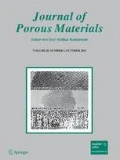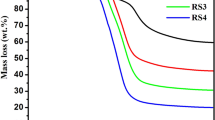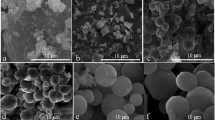Abstract
Carbon spheres were prepared by carbonisation of phenolic resin spheres obtained using a modified Stöber method in a microwave assisted solvothermal reactor. Preparation process involved water–ethanol, ammonia water, resorcinol, potassium oxalate and formaldehyde. The mixture was stirred for 24 h at room temperature and then subjected to a pressure treatment, in which the solution was treated in a microwave assisted solvothermal reactor for 15 min at a pressure of 1–3 MPa. The proposed synthesis resulted in a material containing microporous carbon spheres having high surface area (from 1178 to 1648 m2/g), with diameters from 200 to 350 nm, total pore volume from 0.49 to 0.78 cm3/g, and high CO2 adsorption capacity from 3.86 to 5.03 mmol/g measured at 0.1 MPa and 25 °C. Taking into account the properties of the obtained material, it can be applied as a sorbent for CO2 capture.










Similar content being viewed by others
References
J.B. Smith, D. Tirpak (eds.), The Potential Effects of a Global Climate Change on the United States, Draft Report to Congress, vol. 2 (Environmental Protection Agency, Washington, DC, 1988)
B. Bolin, B.R. Doos, J. Jaeger, R.A. Warrick (eds.), The Greenhouse Effect, Climatic Change and Ecosystems (Wiley, New York, 1986)
G.J. MacDonald, in Preparing for Climate Change, Proceedings of the First North American Conference on Preparing for Climatic Change: A Cooperative Approach (Government Institutes, Rockville, 1988), pp. 108–117
F.I. Woodward, Stomatal numbers are sensitive to increases in CO2 from preindustrial levels. Nature 327, 617–618 (1987)
M.M. Maroto-Valer, Z. Tang, Z. Zhang, CO2 capture by activated and impregnated anthracites. Fuel Process. Technol. 86, 1487–1502 (2005)
K. Labus, S. Gryglewicz, J. Machnikowski, Granular KOH-activated carbons from coal-based cokes and their CO2 adsorption capacity. Fuel 118, 9–15 (2014)
K. Glonek, J. Srenscek-Nazzal, U. Narkiewicz, A.W. Morawski, R.J. Wróbel, B. Michalkiewicz, Preparation of activated carbon from beet molasses and TiO2 as the adsorption of CO2. Acta Phys. Pol. A 129(3), 158–161 (2016)
J. Mlodzik, J. Srenscek-Nazzal, U. Narkiewicz, A.W. Morawski, R.J. Wrobel, B. Michalkiewicz, Activated carbon from molasses as CO2 sorbents. Acta Phys. Pol. A 129(3), 402–404 (2016)
P. Davini, Flue gas treatment by activated carbon obtained from oil-fired fly ash. Carbon 40, 1973–1979 (2002)
C. Lu, H. Bai, B. Wu, F. Su, J.F. Hwang, Comparative study of CO2 capture by carbon nanotubes, activated carbons, and zeolites. Energy Fuels 22, 3050–3056 (2008)
A. Chen, Y. Yu, Y. Li, Y. Li, M. Jia, Solid-state grinding synthesis of ordered mesoporous MgO/carbon spheres composites for CO2 capture. Mater. Lett. 164, 520–523 (2016)
V. Vignal, A.W. Morawski, H. Konno, M. Inagaki, Quantitative assessment of pores in oxidized carbon spheres using scanning tunnelling microscopy. J. Mater. Res. 14(3), 1102–1112 (1999)
M. Nagashima, S. Shimada, M. Inagaki, T.A. Centeno, On the adsorption of CO2 by molecular sieve carbons—volumetric and gravimetric studies. Carbon 33(9), 1301–1306 (1995)
Y.J. Kim, M.I. Kim, C.H. Yun, J.Y. Chang, C.R. Park, M. Inagaki, Comparative study of carbon dioxide and nitrogen atmospheric effects on the chemical structure changes during pyrolysis of phenol-formaldehyde spheres. J. Colloid Interface Sci. 274, 555–562 (2004)
J. Liu, S.Z. Qiao, H. Liu, J. Chen, A. Orpe, D. Zhao, G.Q. Lu, Extension of the Stöber method to the preparation of monodisperse resorcinol–formaldehyde resin polymer and carbon spheres. Angew. Chem. Int. Ed. 50(26), 5947–5951 (2011)
J. Ludwinowicz, M. Jaroniec, Potassium salt-assisted synthesis of highly microporous carbon spheres for CO2. Carbon 82, 297–303 (2015)
N.P. Wickramaratne, J. Xu, M. Wang, L. Zhu, L. Dai, M. Jaroniec, Nitrogen enriched porous spheres: attractive materials for supercapacitor electrodes and CO2 adsorption. Chem. Mater. 26, 2820–2828 (2014)
N.P. Wickramaratne, M. Jaroniec, Activated carbon spheres for CO2 adsorption. ACS Appl. Mater. Interfaces 5, 1849–1855 (2013)
R.E. Riman, W.L. Suchanek, M.M. Lencka, Hydrothermal crystallization of ceramics. Ann. Chim. Sci. Mater. 27(6), 15–36 (2002)
S. Kornarneni, Q. Li, K.M. Stefansson, R. Roy, Microwave-hydrothermal processing for synthesis of electroceramic powders. J. Mater. Res. 8, 3176–3183 (1993)
R. Roy, Acceleration the kinetics of low-temperature inorganic syntheses. J. Solid State Chem. 111, 11–17 (1994)
A. Opalińska, R. Pielaszek, W. Łojkowski, C. Leonelli, H. Matysiak, T. Wejrzanowski, K.J. Kurzydłowski, Grain size and grain size distribution of Pr-doped zirconia nanopowders determined by different methods. Materiały Ceramiczne 62, 550–555 (2010)
J. Kaszewski, S. Yatsunenko, I. Pelech, E. Mijowska, U. Narkiewicz, M. Godlewski, High pressure synthesis versus calcination—different approaches to crystallization of zirconium dioxide. Pol. J. Chem. Technol. 16(2), 99–105 (2014)
D. Sibera, U. Narkiewicz, B. Michalkiewicz, A.W. Morawski, R.J.Wróbel, Metoda otrzymywania sfer węglowych w reaktorze mikrofalowym, jako materiał do sorpcji CO2 (Method for production of carbon spheres in microwave reactor, as material for CO2 sorption), Polish Patent declaration 416007 (2016)
K.S.W. Sing, D.H. Everett, R.A.W. Haul, L. Moscou, R.A. Pierotti, J. Rouquerol, T. Siemieniewska, Reporting physisorption data for gas/solid systems with special reference to the determination of surface area and porosity. Pure Appl. Chem. 57, 603–619 (1985)
S. Brunauer, P.H. Emmett, E. Teller, Adsorption of gases in multimolecular layers. J. Am. Chem. Soc. 60, 309–319 (1938)
N.P. Wickramaratne, M. Jaroniec, Importance of small micropores in CO2 capture by phenolic resin-based activated carbon spheres. J. Mater. Chem. A 1, 112–116 (2013)
J.P. Marco-Lozar, M. Kunowsky, F. Suarez-Garcia, A. Linares-Solano, Gas storage scale-up at room temperature on high density carbon materials. Carbon 72, 125–132 (2014)
S. Lee, S. Park, Determination of the optimal pore size for improved CO2 adsorption in activated carbon fibers. J. Colloid Interface Sci. 389, 230–235 (2013)
M.E. Casco, M. Martinez-Escandell, J. Silvestre-Albero, F. Rodriguez-Reinoso, Effect of the porous structure in carbon materials for CO2 capture at atmospheric and high-pressure. Carbon 67, 230–235 (2014)
L. Wang, R.T. Yang, Significantly Increased CO2 Adsorption Performance of Nanostructured Templated Carbon by Tuning Surface Area and Nitrogen Doping. J. Phys. Chem. C 116, 1099–1106 (2012)
J. Silvestre-Albero, A. Wahby, A. Sepulveda-Escribano, M. Martinez-Escandell, K. Kaneko, F. Rodriguez-Reinoso, Ultrahigh CO2 adsorption capacity on carbon molecular sieves at room temperature. Chem. Commun. 47, 6840–6842 (2011)
V. Presser, J. McDonough, S. Yeon, Y. Gogotsi, Effect of pore size on carbon dioxide sorption by carbide derived carbon. Energy Environ. Sci. 4, 3059–3066 (2011)
X. Hu, M. Radosz, K.A. Cychosz, M. Thommes, CO2-filling capacity and selectivity of carbon nanopores: synthesis, texture, and pore-size distribution from quenched-solid density functional theory (QSDFT). Environ. Sci. Technol. 45, 7068–7074 (2011)
Acknowledgements
The research leading to these results has received funding from the Polish-Norwegian Research Programme operated by the National Centre for Research and Development under the Norwegian Financial Mechanism 2009–2014 in the frame of Project Contract No. Pol-Nor/237761/98.
Author information
Authors and Affiliations
Corresponding author
Electronic supplementary material
Below is the link to the electronic supplementary material.
Rights and permissions
About this article
Cite this article
Sibera, D., Narkiewicz, U., Kapica, J. et al. Preparation and characterisation of carbon spheres for carbon dioxide capture. J Porous Mater 26, 19–27 (2019). https://doi.org/10.1007/s10934-018-0601-8
Published:
Issue Date:
DOI: https://doi.org/10.1007/s10934-018-0601-8




